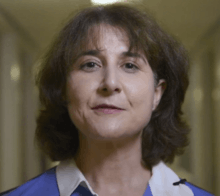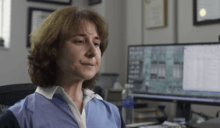Susan Sinnott
Susan Buthaina Sinnott is professor and head of materials science and engineering at Pennsylvania State University.[1][2] Sinnott is a fellow of the Materials Research Society (MRS), the American Association for the Advancement of Science (AAAS) and the American Physical Society (APS). She has served as editor-in-chief of the journal Computational Materials Science since 2014.
Susan Sinnott | |
|---|---|
 Susan Sinnott in 2015 | |
| Born | Susan Buthaina Sinnott |
| Alma mater | University of Texas at Austin (BS) Iowa State University (PhD) |
| Awards | Fellow of the American Association for the Advancement of Science (2010) |
| Scientific career | |
| Fields | Computational materials science Computational physics Computational chemistry[1] |
| Institutions | Pennsylvania State University University of Florida University of Kentucky United States Naval Research Laboratory |
| Thesis | Density functional studies: first principles and semi-empirical calculations of clusters and surfaces (1993) |
| Website | research |
Early life and education
Sinnott studied chemistry at the University of Texas at Austin.[3][4] She moved to Iowa State University for her graduate studies, and earned her doctoral degree in 1993.[3]
Research and career
After graduating Sinnott moved to the United States Naval Research Laboratory where she worked on surface chemistry.[3][5]

After a few years at the Naval Research Laboratory, Sinnott was appointed an assistant professor at the University of Kentucky. She was later recruited to the University of Florida as an Associate Professor in 2000.[3] Sinnott was promoted to Professor at the University of Florida in 2005, where she led projects on cyber infrastructure and quantum theory.[3] In 2015 Sinnott was appointed Head of Materials Science and Engineering at the Pennsylvania State University.[3][7][8]
Sinnott's research involves the development of computational methods to understand the electronic and atomic structure of materials.[1] Her computational models include continuum level modelling and fluid dynamics and take into account material behaviour at the nanoscale.[9] She has investigated the formation and role of grain boundaries, dopants, defects and heterogeneous interfaces.[10][11] Her research has considered perovskites, showing that the alignment or tilting of the perovskite oxygen cages impacts the materials properties.[12] Sinnott has served as editor-in-chief of the scientific journal Computational Materials Science since 2014.[10]
Selected awards and honours
Her awards include:
- 2005 Elected a fellow of the American Vacuum Society[13]
- 2009 Distinguished editor of the Physical Review Letters[14]
- 2010 Elected a fellow of the American Association for the Advancement of Science[15][16]
- 2011 Elected a fellow of the American Ceramic Society[13]
- 2012 Elected a fellow of the Materials Research Society[17]
- 2013 Elected a fellow of the American Physical Society[18]
- 2013 Top 25 Women Professors in Florida[19]
Selected publications
Her publications[1][2] include
- A second-generation reactive empirical bond order (REBO) potential energy expression for hydrocarbons[20]
- Model of carbon nanotube growth through chemical vapor deposition[21]
- Carbon nanotubes: synthesis, properties, and applications[22]
- Effect of chemical functionalization on the mechanical properties of carbon nanotubes[23]
References
- Susan Sinnott publications indexed by Google Scholar

- Susan Sinnott publications from Europe PubMed Central
- "Susan Sinnott — Penn State University - Department of Chemistry". chem.psu.edu. Retrieved 2020-03-05.
- "nanoHUB.org - Members: View: Susan Sinnott". nanohub.org. Retrieved 2020-03-05.
- "SUSAN B Sinnott". ornl.gov. Oak Ridge National Laboratory. Retrieved 2020-03-05.
- Benefunder (2015-06-09), Using Computers to Create New Materials, retrieved 2020-03-06
- "Dr. Susan Sinnott". mse.vt.edu. Retrieved 2020-03-05.
- "Sinnott appointed head of materials science and engineering | Penn State University". news.psu.edu. Retrieved 2020-03-05.
- "Susan Sinnott". Penn State Department of Materials Science and Engineering. 2018-02-16. Retrieved 2020-03-05.
- "Susan Sinnott". journals.elsevier.com. Retrieved 2020-03-05.
- "Interviews with plenary speakers of the XV Brazil-MRS Meeting: Susan Sinnott (Penn State, USA). – SBPMat – Sociedade Brasileira de Pesquisa em Materiais". Retrieved 2020-03-05.
- "A 3D imaging technique unlocks properties of perovskite crystals". news.psu.edu. Penn State University. Retrieved 2020-03-05.
- Madsen, Lynnette (2016-02-01). Successful Women Ceramic and Glass Scientists and Engineers: 100 Inspirational Profiles. John Wiley & Sons. ISBN 978-1-118-73360-8.
- "Physical Review Journals - Outstanding Referees". journals.aps.org. Retrieved 2020-03-05.
- "Three UF researchers named AAAS Fellows - News - University of Florida". news.ufl.edu. Retrieved 2020-03-05.
- "AAAS Members Elected as Fellows". American Association for the Advancement of Science. Retrieved 2020-03-05.
- "Dr. Cammy Abernathy has been recognized as a 2015 Fellow of the Materials Research Society (MRS) – Department of Materials Science and Engineering". Retrieved 2020-03-05.
- "Susan Sinnott elected APS Fellow – Department of Materials Science and Engineering". Retrieved 2020-03-05.
- "Professor Susan Sinnott selected as one of the Top 25 Women Professors in the state of Florida – Department of Materials Science and Engineering". mse.ufl.edu. Retrieved 2020-03-05.
- Brenner, Donald W; Shenderova, Olga A; Harrison, Judith A; Stuart, Steven J; Ni, Boris; Sinnott, Susan B (2002). "A second-generation reactive empirical bond order (REBO) potential energy expression for hydrocarbons". Journal of Physics: Condensed Matter. 14 (4): 783–802. Bibcode:2002JPCM...14..783B. doi:10.1088/0953-8984/14/4/312. ISSN 0953-8984.
- Sinnott, S.B.; Andrews, R.; Qian, D.; Rao, A.M.; Mao, Z.; Dickey, E.C.; Derbyshire, F. (1999). "Model of carbon nanotube growth through chemical vapor deposition". Chemical Physics Letters. 315 (1–2): 25–30. Bibcode:1999CPL...315...25S. doi:10.1016/S0009-2614(99)01216-6. ISSN 0009-2614.
- "Filled Carbon Nanotubes", Carbon Meta-Nanotubes, John Wiley & Sons, Ltd, 2011-10-31, p. 223, doi:10.1002/9781119954743.ch5, ISBN 978-1-119-95474-3
- Garg, Ajay; Sinnott, Susan B. (1998). "Effect of chemical functionalization on the mechanical properties of carbon nanotubes". Chemical Physics Letters. 295 (4): 273–278. Bibcode:1998CPL...295..273G. doi:10.1016/S0009-2614(98)00969-5. ISSN 0009-2614.